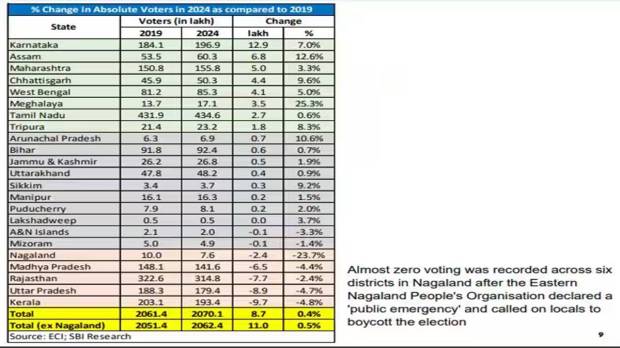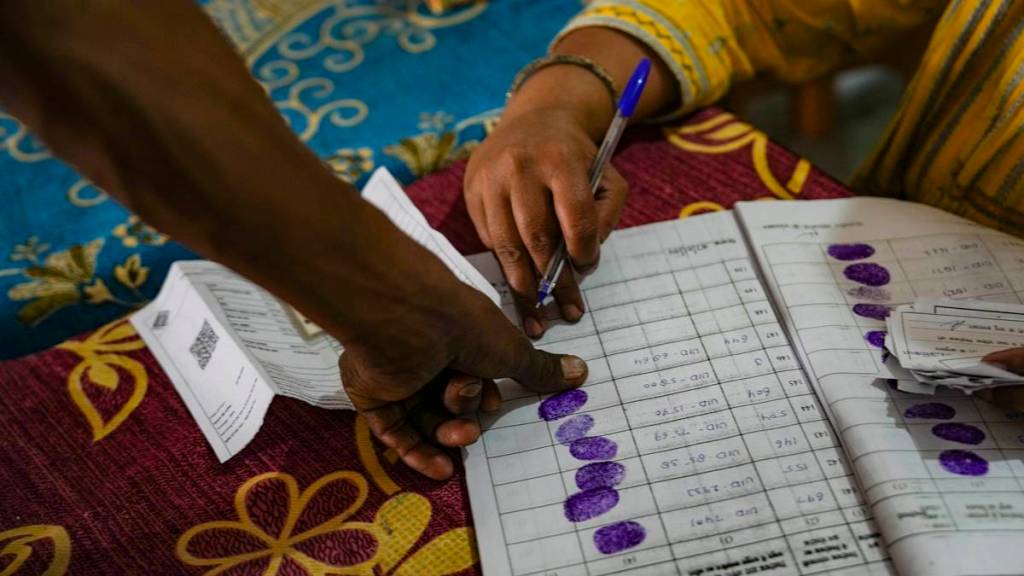Over 8.7 lakh additional voters cast their ballot in the first two phases of the Lok Sabha elections, polling for which was held on April 19 and April 26, an analysis by SBI Research has found. The additional voters correspond to an overall increase of 0.4 per cent over the number of voters who voted in the first two phases of general elections in 2019, it said.
In a report titled ‘White Noise: A J-shaped voting on the anvil’ published on Monday, SBI Research dismissed the concerns around low voter turnout as a “myth”. While the voter turnout ratio shows a declining trend in 2024 when compared to 2019 in percentage terms, there has been a significant increase in terms of absolute voters, it said.
“A clear and better measure of voting pattern is absolute number of voters… In absolute terms, 8.7 lakh more voters/60% of parliamentary constituencies show either an increase or status quo in terms of vote cast in first two phases of general elections 2024… This is a clear improvement of 0.4% above high levels in 2019… women voters continue to outstrip men,” SBI Research said in its report.
“Provisionally, a total of 20.7 crore voters cast their votes in 2024 as compared to 20.6 crore casting their votes in 2019, an increase of 8.7 lakh voters,” it said. The report further added that the numbers can swell in the remaining five phases of elections with earnest efforts from the Election Commission of India and based on voter turnout probabilities.
The report came a day after the poll panel released its final turnout figures for the first two phases of elections. The figures for phase 1 and phase 2 stood at 66.1% and 66.7% respectively, indicating a drop of 3.3 percentage points in phase 1 and 2.5% in phase 2 as compared to the 2019 figures of 69.4% and 69.2% for the corresponding phases.

As per the state-wise trends, Karnataka accounted for the highest number of increase in voters in 2024, followed by Assam and Maharashtra. On the other hand, Kerala accounted for the largest decline in the number of voters in 2024, followed by Uttar Pradesh and Rajasthan.
In terms of constituency-wise trends, absolute voters increased by over 1 lakh in 85 constituencies while a cirresponding decline was seen in 74 constituencies that went to poll in the first two phases. Status quo was maintained in 25 constituencies. A total of 191 constituencies went to polls in the first two phases of elections.
The report further showed that women voters outperformed their male counterparts in terms of the increase in absolute number of additional voters. “The female voters increased by 5.7 lakh while male voters increased by 3.0 lakh… thus female voters outstrip men decisively… Excluding Nagaland where there were calls of vote boycott, the increase in voters were 11 lakh… women voters were 6.8 lakh.”
The report adds that the turnout within constituencies going to polls in the coming phases could be on the higher side, suggesting a possible reversal of the declining trend seen during the seven phases of polls in 2019.
“During 2019, the voting pattern showed a declining trend over the 7 phases, starting at 69.4% and finishing at 61.7% (reaching a cumulative average of 67.7%)….In GE’2024, we believe a reverse phenomenon could be underway, with voting percentage poised for a marked improvement going by the absolute numbers of voting exercised in the first two phases (66.1% & 66.7%),” it said.
The SBI Research further said that its model estimates show the turnout within PCs destined to poll in upcoming phases should be on the higher side, it said, adding that the scorching summer and sweeping heat waves might have played a spoilsport for a certain percentage of voters willing yet unable to exercise the franchise.


